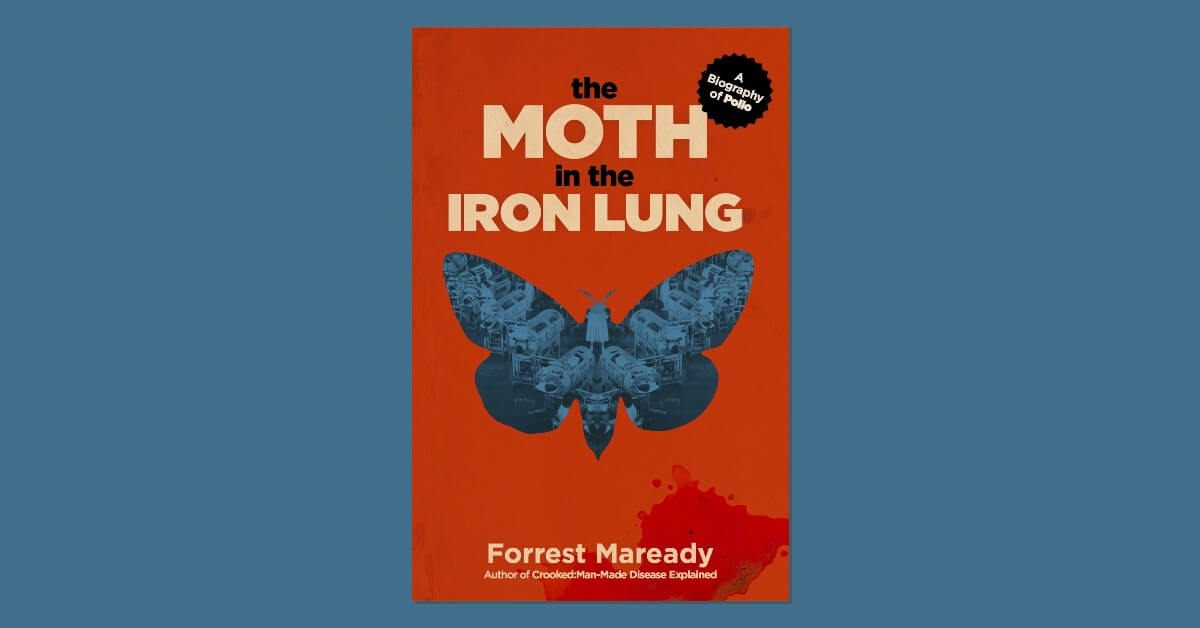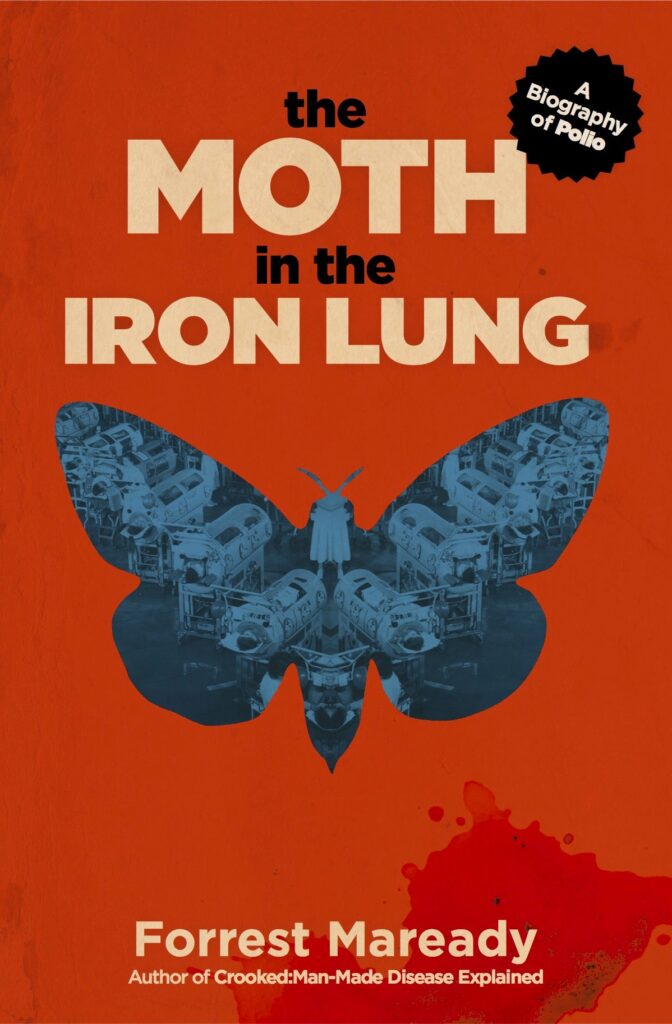The Moth in the Iron Lung Review: This fantastic book by Forrest Maready is, like the subtitle promises, “A Biography of Polio.” It goes deep on the subject and makes connections you haven’t heard before.
The Moth in the Iron Lung reads like a thriller winding through stories of toxic medicine, devastating insect infestations, and treacherous disease outbreaks.
The fiction of Jonas Salk saving the day with his miraculous polio vaccine, putting an end to barbaric iron lungs, heartbreaking disfigurations, and terrifying deaths is not accurate. Same old lies, and deception to push a narrative.
This historical account from Maready sounds eerily familiar with COVID vaccine nonsense pumped out by corporate media and government officials today. Almost like it’s pulled from a playbook. Gain of function and a potential lab leak. Truth tellers silenced. Definitions changed. Unvaccinated vilified. Massive propaganda. Vaccines are pumped as miracle cures. And, ultimately, delivering vaccines at all costs no matter their efficacy.
Here are the highlights of The Moth in the Iron Lung.
- The Moth and the Iron Lung
- Compromised Immune System Leads to Disease
- Cause and Effect
- Zeroing In on the Wrong Thing
- The Best Science Money Could Buy Justifies More Toxic Applications
- DDT Blitzkrieg
- Jonas Salk and the Polio Vaccine Con Job
- The Zika Story
- The Moth in the Iron Lung Review: 5 Stars (Highly Recommended)
Compromised Immune System Leads to Disease
There’s a theory that says all the bacteria and viruses are already all around us, on our skin, and in our body. But, if you have clean systems in place, including drinking water and effective waste removal, maintaining your health and fitness, and restricting toxin exposure, your immune system can handle all of the pathogens you encounter daily.
A compromised body invites health problems. I’m not getting into terrain theory versus germ theory, and if viruses exist, but it’s quite reasonable to think that having an overwhelming toxic load can damage your organs and weaken your immune system, making you more susceptible to ubiquitous pathogens.
Cause and Effect
In hindsight, it’s easy to see that pesticides and poisons parading around as medicines, insecticides, and colorants increased the spread of disease. Maready documents this.
- Teething powders made with mercury triggered an epidemic of infantile paralysis.
- Insecticides to kill the gypsy moth triggered an outbreak of poliomyelitis (the actual name of the disease) in rural communities outside of Boston.
- Toxic additives to wallpaper, toys, fabric, and building materials caused a steady stream of health issues.
- Widespread crop dusting with lead arsenate after WWI lead to even more widespread disease.
- The full-blown frontal assault of DDT on the population post-WWII.
Zeroing In on the Wrong Thing
Polio baffled the world for decades. Part of the roadblock to discovering the real truth was hard-headed scientific and medical communities. They boiled down the cause to one thing, the poliovirus, and based their research and responses on that. They ignored and ostracized alternative theories and compelling evidence going against that narrative.
Scientist Edward Rosenow discovered that victims from the 1916 epidemic had a form of the Streptococcus bacteria. He performed experiments on 2,000 animals and discovered he could give them poliomyelitis by injecting them with this bacteria. Rosenow was able to use new microscope technology to confirm his finding.
Even Simon Flexner from the Rockefeller Institute concluded that a microbial form was causing poliomyelitis.
Unfortunately, the prevailing narrative was easier to understand and sell to the American public: the only cause of poliomyelitis was the poliovirus. This made combating the disease and its multi-vector causes more difficult, and cost thousands of lives.
The Best Science Money Could Buy Justifies More Toxic Applications
There are several examples in the book of the pesticide industry paying scientists to perform safety studies on their products. Conflict of interest? Also, governmental regulatory bodies turned a blind eye to mounting evidence. Regulatory capture?
These studies had glaring omissions because of incompetence or purposeful deceit.
They never examined chronic accumulation nor the interactions between pesticides and pathogens. They only looked at the likelihood of acute poisoning (i.e. effects of pesticides at one point in time).
By the end of the 19th century many states, emboldened by the dodgy studies and propaganda, and not listening to the concerns of their constituencies, passed laws requiring farmers to spray their crops.
DDT Blitzkrieg
DDT was first synthesized in 1874 but didn’t catch on until the 1930s. Soldiers were sprayed in WWII to help control typhus and malaria.
It was a miracle concoction the American public welcomed with open arms despite decades of hell wreaked by similar chemical concoctions.
After WWII ended, the United States put its manufacturing might to the task of pumping out loads of DDT. Trucks fogged neighborhoods while children ran in the clouds. Ads touted products with “contains DDT” as the main selling point.
They doused children with sprays and powders at every opportunity to keep them safe from disease-spreading insects. DDT was also used in the burgeoning industrialized farming industry.
Paralysis rates skyrocketed: 13,000 in 1945. Nearly double that in 1946.
In 1947 a New York physician named Morton Biskind published a report in the American Journal of Digestive Diseases suggesting that DDT may be the cause of a disease outbreak very similar to poliomyelitis. But it took several years before the public began to sour on the miracle pesticide.
In 1951, 28,000 people were stricken with poliomyelitis and 1,551 of them died.
In 1952, 3,145 people died. A groundswell against DDT began forming as the numbers of sufferers continued to rise, and it was becoming apparent that pests were becoming resistant to it. Agricultural applications continued but they stopped direct dusting and spraying of children.
Over the next five years, deaths dropped. In 1957 there were only 221. Many credit the vaccine for this improvement.
Jonas Salk and the Polio Vaccine Con Job
Jonas Salk’s first shipment of vaccines in 1955 was recalled for improper preparation. They were causing paralysis and death. This shook the public, making them, shall we say, vaccine-hesitant. They weren’t able to get the jab program off the ground for another two years. This conflicts with the idea that vaccines helped reduce the poliomyelitis numbers in 1957.
Also, after further study Salk vaccine shortcomings surfaced. Salk vaccines could only create antibodies within the bloodstream. This was enough protection to keep the pathogen from reaching the nervous system. However, “they realized it could do nothing to prevent the intestines from harboring–and excreting–the virus by the millions.” This meant the Salk vaccine could not prevent the spread of the disease.
It also meant that lifelong vaccination would be required, especially since they also discovered the vaccine only generated antibodies that lasted for a few years.
And, of course, as they tried to improve the vaccine they added a preservative called thimerosal, which was mercury-based (here we go again with the toxic medicines).
Similar to how C-19 vaccines are working today. They don’t protect the vaccinated from getting COVID, nor do they keep them from spreading the disease. They lessen the symptoms, which increases the likelihood that the infected will spread it. Oh, and they come with a boatload of side effects, like blood clotting, heart inflammation, and increased likelihood of cancer.
The fraudulent historical account of Salk and his miracle polio vaccine laid the groundwork for today’s medical tyranny.
By 1963 poliomyelitis had all but disappeared from the U.S. because of reduced use of lead arsenate and DDT.
The Salk vaccine most likely did more harm than good.
The Zika Story
Maready naysayers can’t abide by the conclusions taken from The Moth in the Iron Lung. How could the historians be so wrong? How could he sully Salk’s glorious reputation? In response, Maready relates the story of the Zika virus from 2015.
There was a rash of babies in Brazil born with undersized heads (microcephaly). Health officials couldn’t figure it out. Locals pointed out the recent release of genetically modified mosquitoes and aggressive pesticide spraying in the area.
Despite the worldwide panic, the Zika virus was no longer causing undersized heads by 2016 because they removed the toxic environmental inputs in Brazil. Vaccine development halted. They were too late to take credit for the victory over the virus.
Most likely the polio vaccination would have had the same fate if Salk and company had not rushed their product to market before it was obvious poliomyelitis was no longer a problem.

